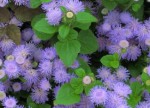 Flossflower is an annual belonging to the aster family (Asteraceae)and native to Mexico. It has become an invasive weed in some areas of the world while bred into a common bedding plant in US gardens where it is prized for its easy care and very long bloom time. Most of the cultivated plants are short, compact, and mound forming and are suitable for containers or the front of the border. They have soft green rounded leaves that are hairy and have a chordate base. The dense flower heads are composed of small tubular flowers in terminal corymbs surrounded by greenish bracts covered with sticky hairs. The flowers are blue in the species but may be white, pink, or red in cultivars. Each floret has two elongated style branches that give the flower heads a fuzzy appearance. The fruits are achenes and need light to germinate.
Flossflower is an annual belonging to the aster family (Asteraceae)and native to Mexico. It has become an invasive weed in some areas of the world while bred into a common bedding plant in US gardens where it is prized for its easy care and very long bloom time. Most of the cultivated plants are short, compact, and mound forming and are suitable for containers or the front of the border. They have soft green rounded leaves that are hairy and have a chordate base. The dense flower heads are composed of small tubular flowers in terminal corymbs surrounded by greenish bracts covered with sticky hairs. The flowers are blue in the species but may be white, pink, or red in cultivars. Each floret has two elongated style branches that give the flower heads a fuzzy appearance. The fruits are achenes and need light to germinate.
Type: Annual
Bloom: Blue, white, pink, red tubular flowers appear in dense heads from spring until the first frost.
Size: 6-24” H x 12” W
Light: Full sun, partial shade
Soil: Fertile, medium moist, well-drained
Hardiness: Not relevant
Care: Fertilize with slow release granular fertilizer; water deeply when the soil is dry 2-3 inches below the surface; deadhead when necessary to keep plants compact.
Pests and Diseases: Generally pest free but susceptible to Southern blight and crown and root rot can be a problem. Powdery mildew and rust may be a problem during dry periods, botrytis blight during wet, cool periods.
Propagation: Seed (do not cover seeds with soil)
Companion plants: Pink begonias Begonia spp), lamb’s ear (Stachys), white flowering petunias, ‘Icicle’ spike speedwell, ‘Silver Cup’ mealycup sage, yellow comos (Cosmos suphureus), dark blue lobelia (Lobellia spp), yellow cockscomb (Celosia spp)